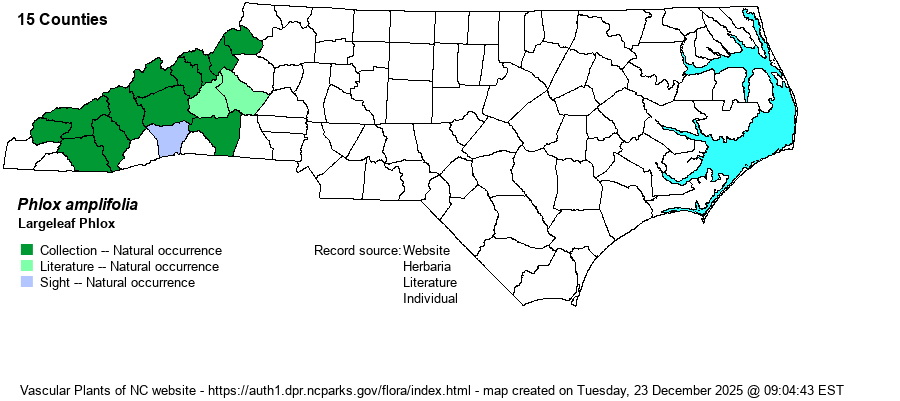| Author | Britton | |
| Distribution | Present over most of the Mountains; range extends east to several counties located along the Blue Ridge Escarpment, but it appears to be absent from the Piedmont.
This is a Mid-South species, ranging only from western VA west to MO, and then south through the Appalachians to northern GA and central AL. | |
| Abundance | Uncommon to locally infrequent, despite being found in the majority of Mountain counties in the state. This is a Watch List species, as identified by the NCNHP. However, the website editors feel that the S2 State Rank assigned by NCNHP is too conservative, and suggest that S2S3, if perhaps S3, is more accurate. | |
| Habitat | This is a species of mesic to rich forests, over high pH soil; most populations are found in Rich Cove Forests or in richer portions of Northern Hardwood Forests. | |
| Phenology | Blooms from July to August, and fruits in the same time frame. | |
| Identification | This is among the tallest and most robust species of Phlox in the state, often reaching 3 feet high, to rarely 4 feet high. The erect stem has opposite leaves at 8-15 nodes along the stem; most other similar species have many more stem leaves. Each blade is about 4 inches long and 1.5 inches wide, ovate to nearly rhombic (diamond) in shape, with an acuminate tip and some leaf pubescence below. At the end of the stem is a moderately large panicle of numerous rose-colored flowers, with the inflorescence often pyramid-shaped and about 4 inches tall and wide. Each flower is the typical Phlox shape of a long and narrow tube and 5 flaring lobes, about 1-inch long and not quite 1-inch across the front. The main species of confusion is Phlox paniculata, which has many more pairs of leaves, typically 15-40 instead of 8-15; has some leaves alternate or only sub-opposite toward the top of the stem (versus all opposite in P. amplifolia); the corolla tube pubescent versus glabrous in P. amplifolia; and leaves narrower (usually 3-4 times as long as wide), versus leaves about 2-3 times as long as wide in P. amplifolia. Also, P. paniculata tends to grow more along stream margins or damp ground, as well as along wooded margins and can appear somewhat weedy; P. amplifolia tends to occur in high-quality forested sites with rich soil. | |
| Taxonomic Comments | None
| |
| Other Common Name(s) | Broadleaf Phlox | |
| State Rank | S2 [S2S3] | |
| Global Rank | G3G5 | |
| State Status | W1 | |
| US Status | | |
| USACE-agcp | | |
| USACE-emp | | |

